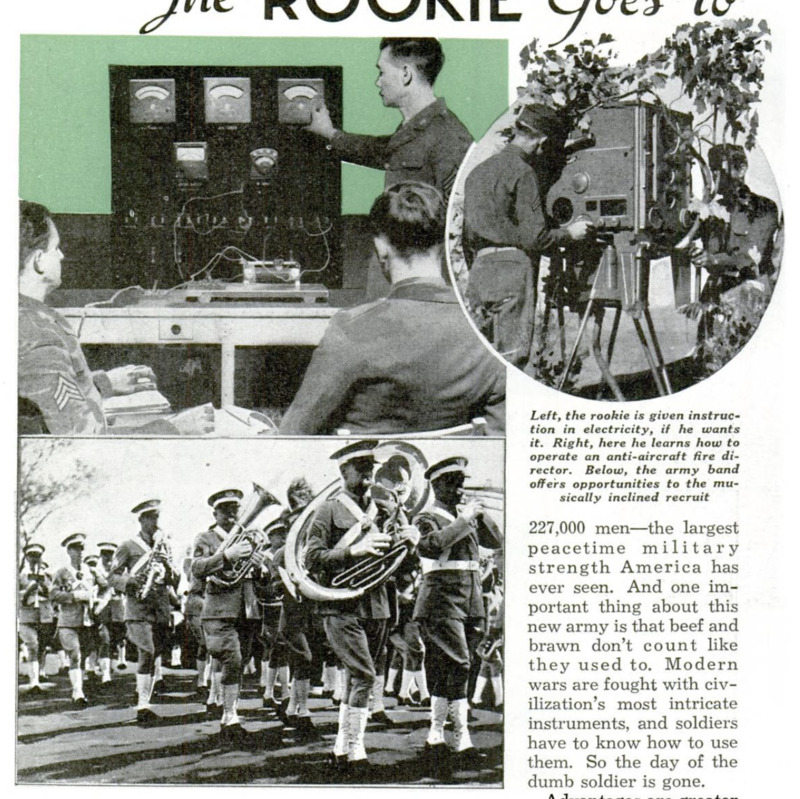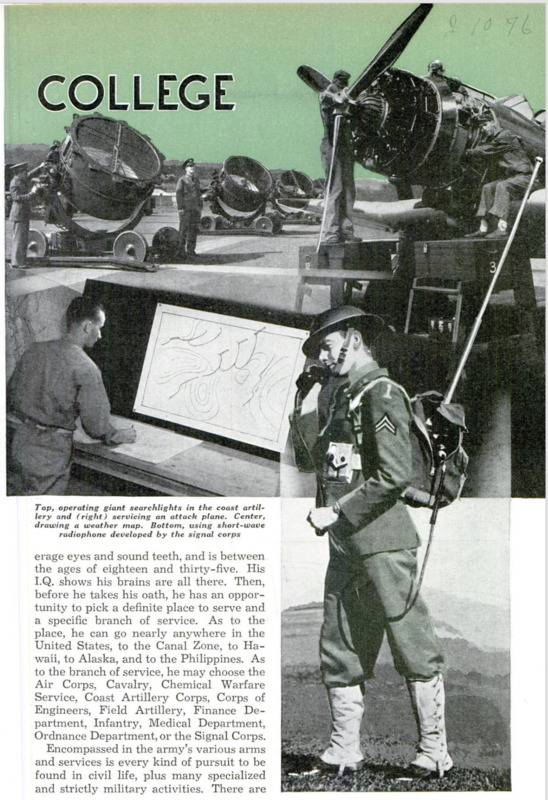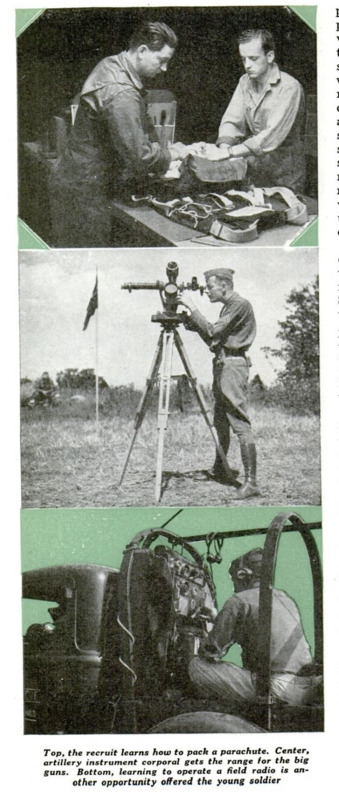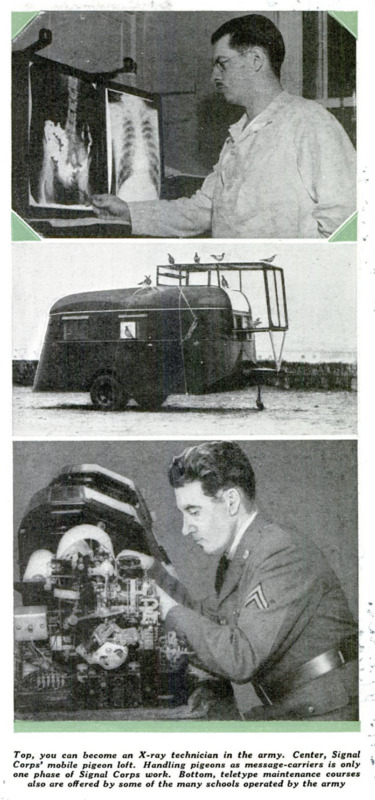“WHAT I want to know,” the red-haired, freckle-faced youth said, “is do you learn anything in this army besides how to shoot guys.” The recruiting sergeant grinned and replied: “You bet you learn something in this army besides how to shoot guys. Today’s army is streamlined and technical, and they won't even let you enlist unless you can prove you have the necessary brains to learn with.” Uncle Sam is in the midst of a campaign to build up the regular army to a total of 227,000 men - the largest peacetime military strength America has ever seen. And one important thing about this new army is that beef and brawn don't count like they used to. Modern wars are fought with civilization’s most intricate instruments, and soldiers have to know how to use them. So the day of the dumb soldier is gone. Advantages are greater in today’s army. Standards for enlistment are higher. The recruit must present a good school record, and if he’s ever been in trouble with the police the army won’t take him as a gift. Suppose our red-haired boy is among the thousands of new men now being sworn in. Where can he go, what can he see, what can he learn? We'll assume he hasn't a police record, and that he gets checked through with a physical O.K. He’s at least five feet four inches tall, not under 115 pounds, has average eyes and sound teeth, and is between the ages of eighteen and thirty-five. His L.Q. shows his brains are all there. Then, before he takes his oath, he has an opportunity to pick a definite place to serve and a specific branch of service. As to the place, he can go nearly anywhere in the United States, to the Canal Zone, to Hawaii, to Alaska, and to the Philippines. As to the branch of service, he may choose the Air Corps, Cavalry, Chemical Warfare Service, Coast Artillery Corps, Corps of Engineers, Field Artillery, Finance Department, Infantry, Medical Department, Ordnance Department, or the Signal Corps. Encompassed in the army’s various arms and services is every kind of pursuit to be found in civil life, plus many specialized and strictly military activities. There are places for stenographers, newspapermen, artists, draftsmen, surveyors, X-ray technicians, photographers, cooks, bakers, precision machinists, metal workers, weather forecasters, veterinarians, radio operators and technicians, chemists, sign-painters, plumbers, accountants, airplane mechanics, storekeepers, and even salesmen, such as the recruiting service itself. Each of the army’s branches maintains fine schools, where the necessary training is administered with the systematic thoroughness that is one of the army’s finest characteristics. Suppose our red-haired recruit decides to give the Air Corps a whirl. He enlists for one of the regular units overseas or in “The States.” After he gets to his field, whether his unit is bombardment, attack, pursuit or observation, he'll go through a basic course of instruction, a sort of a shaking-down process. When this is over, he'll be assigned to the kind of work for which he seems best fitted. The Air Corps, of course, has fascinating possibilities. They include aerial photography, airplane engine and airplane maintenance, armament and machine shop work, meteorology, parachute rigging, radio operation and maintenance, sheet metalcraft, welding - and even traffic dispatching, Enlisted men are not pilots, but those properly qualified may be sent to Randolph Field, “West Point of the Air,” where they are turned out as officers and fliers. However, they get plenty of passenger-flying as observers, as aerial cameramen, as radio operators, and as mechanical checkers on test flights. Each year about 500 outstanding men, selected from Air Corps stations throughout the army, are sent to the Air Corps Technical School at Chanute Field, IIL, one of the finest aviation schools in the world. If there’s such a thing as a second choice, the rookie might look over the Signal Corps. This is also a highly tecnical branch, offering training of great value in civil life. Nerve system of the army, it includes every kind of communication known to man, even carrier pigeons. This corps installs and maintains telephone systems, runs a vast and intricate wireless network, and is also the army’s official photographer. Assignments available in this corps include telephoneelectricians, linemen, switchboard operators, teletype maintenance men, radio operators, radio repairmen, and others as diverse as the com- munications industry itself. Army radio operators are on all the big army transports plying the Atlantic and the Pacific, and they're scattered ashore all along the line. Alaska is connected with The States by army radio men of the Signal Corps, who supply much valuable data enabling accurate weather forecasts. The Signal Corps, like the Air Corps, maintains a school. It is at Fort Monmouth, N. J, and qualified enlisted men are sent there every year for systematic training. One branch of the army that's closely allied with civil projects is the Corps of Engineers. Army engineers built the Panama Canal, miles upon miles of Mississippi levees, they’re building the great Fort Peck Dam, and they have constant supervision over America’s navigable rivers and harbors. If the rookie wants technical training in the army, he can find it about as technical as it comes in the engineers. One of the famous units is the 29th Topographical Battalion, now stationed in the wilds of the Olympic Peninsula, opposite Seattle. This unit surveyed the Nicaraguan Canal route, and its work in aerial mapping on the Olympic Peninsula was the first thorough workout of this method of map-making over the most difficult terrain imaginable. Army engineers build roads, bridges, railways, buildings, and the range of technical jobs embraces stationary enginemen, instrument repairmen, lithographers, photographers, painters, rodmen, structural ironworkers, draftsmen, and so on. The Engineer School is at Fort Belvoir, Va. The Quartermaster Corps is the supply and general maintenance service of the” army - and it’s extremely important. Members of the QMC are often called the “buinessmen of the army.” They have to buy Supplies and keep the transportation system going. In this day of motorization, the Transportation Division is of singular importance, and the QMC operates big motor transport schools, where enlisted men learn to take automotive engines apart and put them back together. Equal in importance is the Property Division, which, among other things, keeps the soldiers clothed and equipped. A sales division operates commissaries and stores, as well as bakeries. Utilities are managed by another division. The Quartermaster Corps also operatesa fleet of transports and other ships. The Quartermaster Corps probably runs more kinds of schools than any other branch of the army. There is the main Quartermaster School at Philadelphia, teaching practical business methods, and a Quartermaster Motor Transport School at Camp Holabird, near Baltimore, Md. Schools for bakers and cooks are maintained at nine different posts in the United States and foreign departments. There is also a Horseshoers School at Fort Riley, Kan., and selected soldiers are sometimes sent to civilian institutions, such as the GeneralMotors Institute at Flint, Mich., and the
Bendix Safety Service School at South Bend, Ind. There are two other important branches of technical training, the Medical Department, and the Finance Department. From the first of these come the famous microbe hunters, unsung heroes who have saved millions of lives from malaria, dengue fever, and other scourges of humanity. The Medical Department embraces the Medical Service proper, the Dental Service, and the Veterinary Service. At the Army Medical Center in Washington, D. C., enlisted men can attend two courses a year for developing X-ray, laboratory, dental and veterinary technicians. There is also an important School of Aviation Medicine at Randolph Field, Tex. Graduates of this school become assistants to flight surgeons. There is a vast amount of paper work in the army, and lots of money to handle. The Finance Department does it, and expert bookkeepers, accountants, cashiers, clerks, stenographers and other specialists are trained in the Finance School, at Washington, D. C. Another technical branch is the Ordnance Department, charged with the maintenance of arms, where a high degree of skill in precision machine work is developed. The Ordnance Field Service School is at Raritan Arsenal, N. J.
 Popular Mechanics, v. 73, n. 2, 1940
Popular Mechanics, v. 73, n. 2, 1940









